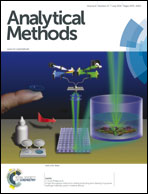Detection of quinolone antibiotics with electrochemiluminescence of bimetallic ruthenium complex [(bpy)2Ru(bpy)(CH2)8(bpy)Ru(bpy)2]4+†
Abstract
Electrochemiluminescence (ECL) of bimetallic ruthenium tris-bipyridyl complex [(bpy)2Ru(bpy)(CH2)8(bpy)Ru(bpy)2]4+ at a glassy carbon electrode has been employed for the determination of the four widely used quinolone antibiotics. The method gave a linear response from 1.0 × 10−13 to 1.0 × 10−6 mol L−1, 1.0 × 10−14 to 1.0 × 10−7 mol L−1, 1.0 × 10−15 to 1.0 × 10−6 mol L−1, and 1.0 × 10−15 to 1.0 × 10−6 mol L−1 concentration ranges for ofloxacin, levofloxacin, norfloxacin, and ciprofloxacin, respectively. Remarkable quantitation limits of 1.0 × 10−13, 1.0 × 10−14, 1.0 × 10−15, and 1.0 × 10−15 mol L−1 were observed for the detection of ofloxacin, levofloxacin, norfloxacin, and ciprofloxacin in phosphate buffer (0.10 mol L−1). These detection levels were much lower than those observed for other detection methods. The proposed method was successfully employed in the determination of ofloxacin, levofloxacin, norfloxacin, and ciprofloxacin after their addition into milk samples. Good reproducibility and stability were observed. This method allows for the development of an ECL-based method for the detection of quinolone antibiotic residues.
![Graphical abstract: Detection of quinolone antibiotics with electrochemiluminescence of bimetallic ruthenium complex [(bpy)2Ru(bpy)(CH2)8(bpy)Ru(bpy)2]4+](/en/Image/Get?imageInfo.ImageType=GA&imageInfo.ImageIdentifier.ManuscriptID=C4AY00632A&imageInfo.ImageIdentifier.Year=2014)

 Please wait while we load your content...
Please wait while we load your content...